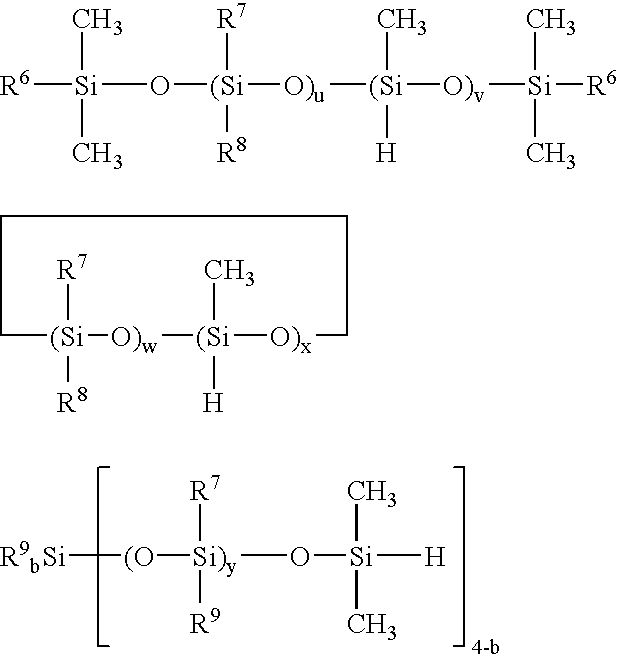Silicone adhesive and silicone adhesive film
a technology of adhesive film and silicone, which is applied in the direction of adhesives, film/foil adhesives, etc., can solve the problems of insufficient polyimide resins to mitigate thermal stress, insufficient product productivity, and inability to apply adhesives for a long tim
- Summary
- Abstract
- Description
- Claims
- Application Information
AI Technical Summary
Benefits of technology
Problems solved by technology
Method used
Image
Examples
synthesis example 1
of Component (A)
[0055]In 200 parts of toluene were dissolved 100 parts of a methylpolysiloxane resin consisting of 0.678 mol of (CH3)3SiO1 / 2 units, 0.072 mol of (CH═CH2)(CH3)2SiO1 / 2 units, and 1 mol of SiO2 units (hydroxyl content or OH number: 0.06 mol / 100 g methylpolysiloxane resin) and 100 parts of a gum-like dimethylpolysiloxane end-capped with a hydroxyl radical, containing 0.075 mol % (based on all the organic radicals bonded to silicon atoms, same hereinafter) of vinyl radicals as pendants and having a degree of polymerization of 2,000. To the solution was added 1.0 part of 28% aqueous ammonia. The solution was stirred at room temperature for 16 hours for condensation reaction to take place. By heating at 120–130° C., the condensation water was removed through azeotropic dehydration. The solution was cooled to room temperature, after which 100 parts of toluene was added, and a 2-ethylhexanol-modified chloroplatinic acid solution added in an amount to give 10 ppm platinum. Aft...
synthesis example 2
of Component (A)
[0056]As in Synthesis Example 1, a silicone composition II was synthesized using 100 parts of a methylpolysiloxane resin consisting of 0.685 mol of (CH3)3SiO1 / 2 units, 0.065 mol of (CH═CH2)(CH3)2SiO1 / 2 units, and 1 mol of SiO2 units (hydroxyl content or OH number: 0.07 mol / 100 g methylpolysiloxane resin), 100 parts of a gum-like dimethylpolysiloxane end-capped with a hydroxyl radical, containing 0.075 mol % of vinyl radicals as pendants and having a degree of polymerization of 2,000, 100 parts of toluene, 1.0 part of 28% aqueous ammonia, an amount to give 10 ppm platinum of a 2-ethylhexanol-modified chloroplatinic acid solution, and 6.0 parts of trimethoxysilane.
synthesis example 3
of Component (A)
[0057]As in Synthesis Example 1, a silicone composition III was synthesized using 100 parts of a methylpolysiloxane resin consisting of 0.725 mol of (CH3)3SiO1 / 2 units, 0.025 mol of (CH═CH2)(CH3)2SiO1 / 2 units, and 1 mol of SiO2 units (hydroxyl content or OH number: 0.05 mol / 100 g methylpolysiloxane resin), 100 parts of a gum-like dimethylpolysiloxane end-capped with a hydroxyl radical, containing 0.075 mol % of vinyl radicals as pendants and having a degree of polymerization of 2,000, 100 parts of toluene, 1.0 part of 28% aqueous ammonia, an amount to give 10 ppm platinum of a 2-ethylhexanol-modified chloroplatinic acid solution, and 2.0 parts of trimethoxysilane.
PUM
| Property | Measurement | Unit |
|---|---|---|
| Percent by mass | aaaaa | aaaaa |
| Percent by mass | aaaaa | aaaaa |
| Percent by mass | aaaaa | aaaaa |
Abstract
Description
Claims
Application Information
 Login to View More
Login to View More - R&D
- Intellectual Property
- Life Sciences
- Materials
- Tech Scout
- Unparalleled Data Quality
- Higher Quality Content
- 60% Fewer Hallucinations
Browse by: Latest US Patents, China's latest patents, Technical Efficacy Thesaurus, Application Domain, Technology Topic, Popular Technical Reports.
© 2025 PatSnap. All rights reserved.Legal|Privacy policy|Modern Slavery Act Transparency Statement|Sitemap|About US| Contact US: help@patsnap.com



